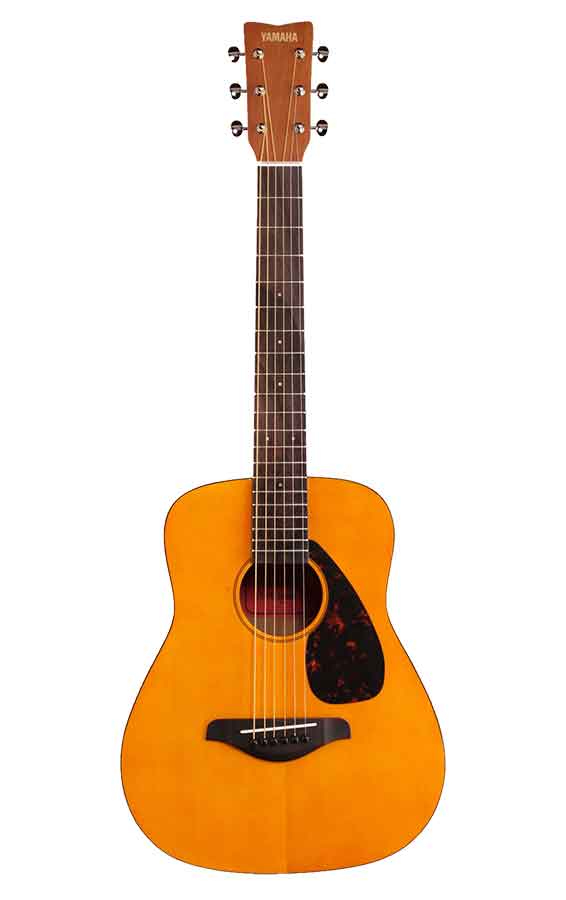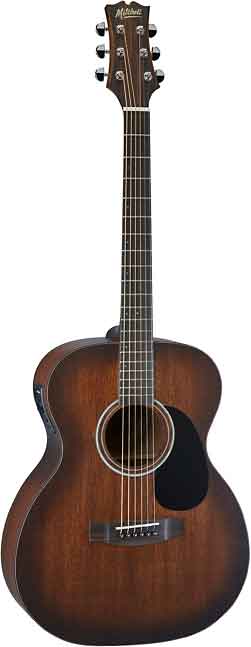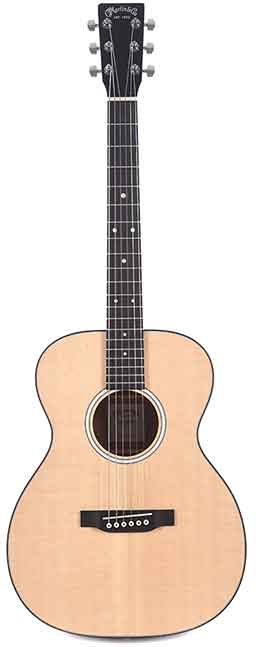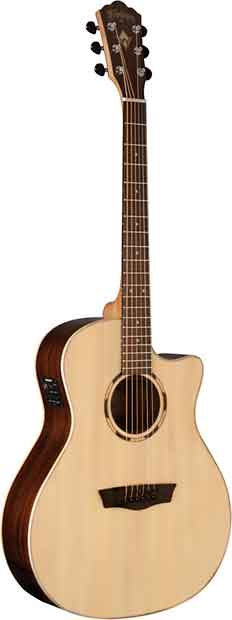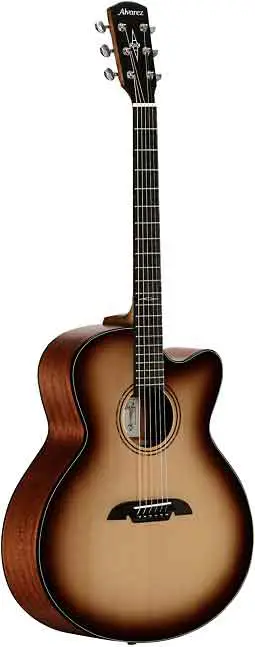When looking to purchase an acoustic guitar, whether it’s your first or twenty-first, options abound. One of the many options is the guitar’s size or body type. The body type not only has an effect on how the guitar feels when holding it, but there are tonal implications as well.
Each size will have its own distinct sound qualities and will be suited for different playing styles. I have literally played every single body type of acoustic guitar out there and as a superfan of the acoustic guitar, it is impossible for me to pick a single favorite. However, I do have a favorite body type for different applications.
Before detailing the different acoustic guitar body types, it’s important to define a few terms that have to do with the parts of the guitar body.
The guitar’s anatomy is described in humanoid terms and these are going to be the distinguishing parts of each body type. The shoulders are the part of the body between the soundhole and the neck joint, while the hip is the rounded section from the soundhole to the butt end of the guitar. In between the two is a curvature that squeezes inward toward the soundhole which is the waist.
When talking about guitar size, the scale length will also be an identifiable factor, although this is not something that most people can readily perceive. Scale length is the length of the string from the nut to the saddle. Also, body depth is important to consider for how big or small the guitar will feel to its wielder, and how the guitar may sound.
Acoustic guitar body types will vary from one guitar maker to another, so there will be differences in the nomenclature and dimensions. A Triple-0 Martin may have different dimensions than Gibson’s. “00” might be synonymous with a classical model. Some brands might have their Auditorium guitar listed as a 00 whereas some will have it as a 000.
There may be other guitar makers who have proprietary sizes or hybrid body types that combine distinctive body type qualities. What makes the various guitar sizes most identifiable is the shape created by the various curves of the actual guitar body.
Confusing? Don’t worry; there’s no need to split hairs. we will cover the general sizes and from there, as you move from brand to brand, you will get a feel for some of the subtle differences.
Acoustic Guitar Body Types (from smallest to largest)
- Traveler
- Folk / Student Model
- Parlor
- 0
- 00
- 000
- Orchestra Model
- Dreadnaught
- Jumbo
Traveler: Martin Backpacker – $233.95
This is not considered a “standard” size guitar, but it’s worth mentioning for those who want a compact travel companion. The Martin Backpacker actually sounds great. Of course, it won’t have a big, booming tone but for such an odd body shape, it has a good quality sound and is great for those hotel stays on a business trip, or at a friend’s bonfire.
This is a 15-fret guitar with nylon strings. It’s a 24” scale length which means it measures 24 inches from the nut at the top of the fretboard to the bridge saddle. Here’s a little demo of what it sounds like.
Folk Guitar: Yamaha JR1 – $150
A ¾-size guitar is great for those who find standard guitars a little too cumbersome, or for those who are exploring learning guitar and want a good quality instrument on the cheap. These are considered student models since the demographic tends to be kids about 12 years or younger, but adults can comfortably play these as well.
Another term for a ¾ guitar is “folk guitar”. It has a 21.25” scale length and although that is smaller than the travel guitar, the body size in total will be bigger. The body depth is less than 4” which keeps the overall volume low and gentle sounding – great for a new player or if you have noise-sensitive neighbors.
Here’s a video demo of one of my favorite ¾ guitars, the Baby Taylor ¾.
Parlor: Fender CP-60S – $200
Parlor guitars were popular from the late 1800s all the way up to the 1950s. They experienced a resurgence in the 2000s and are used a lot these days by singer-songwriters as well as jazz and blues guitarists going for a sound with more emphasis on the mid-range frequencies.
These guitars have a scale length in the neighborhood of 24.75” and are referred to oftentimes as a “12-fret” or “14-fret” guitar depending on where the neck meets the body. The older parlor guitars were 12-fret guitars, whereas many modern variations such as the Fender are 14-fret guitars.
A good example of the Parlor guitar in all its glory is Robert Johnson performing “Crossroads”.
For a more modern application, Ed Sheeran has used it on “You Need Me, I Don’t Need You”
Single “0” / Concert: Recording King Dirty 30’s Series 7 Single 0 – $169.99
The first of the “standard” size guitars is the “0” (read: single-o or single aught). There will be some synonyms for the 0 depending on the manufacturer. Some parlor guitars will fit into this category along with some classicals. The most common name for single 0 guitars is the “concert size”.
Standard scale length on these guitars is 25.5” and parlor guitars that have the neck joined with the body at the 14th fret will often fall into this category. There are also concert size guitars that are 12-fretters. These have a bright sound and are popular with folk and blues guitar styles as well as finger-pickers.
A good video to see the Single-O in action is a demo by Jonathan Brown playing a guitar made by Pre-War Guitars Co.
00 / Grand Concert: Ibanez AC3400PN – $299.99
00 guitars are typically referred to as “Grand Concert”, but classical guitars can also fall into this category. These will be on the shorter scale, most of them coming in just under a 25” scale length, but will usually have a bigger, wider hip.
Grand concerts are preferred by finger pickers as they have a great response when played lightly. These guitars do not get very loud with a strong strum, so they have a high floor and low ceiling with the volume levels.
Bob Dylan was famous for his use of his Martin 00 for the first few years of his career.
000 / Auditorium: Mitchell T333E – $229 // Martin 000Jr-10 – $499
Sizes in the range of 000, auditorium, and orchestra tend to overlap. Different manufacturers will label them differently depending on other lines or models they have in their repertoire. Some lines will not carry a “000” model, some will not carry an “auditorium”. Martin has a line called the “grand performance” that fits the bill as well.
Generally speaking, the 000 size is going to be a shorter scale – around 24” to just under 25”, but have a wider, deeper body than the 00. This size guitar is more true to a typical classical guitar but in a steel-string package. Unlike a classical, the neck on the steel-string guitar will not be as beefy.
Triple-O guitars when compared to the double-O will often have a convex back which will offer more low-end and greater “dynamic range”, meaning more response from the guitar at a wider range of volume levels. In general, the 000 will be louder.
Some manufactures still will have sizes described as a “Grand Auditorium”. Some makers will have these listed as either 000 or 0000 depending on the exact specifications and how the size compares with other models in their line.
The triple-O can be heard in its glory in what is arguably one of the greatest acoustic performances ever – Eric Clapton’s unplugged concert in 1992.
Orchestra Model: Washburn WLO2SCE – $335
The orchestra model, or OM, is going to have a body similar to a 000, but with a longer scale of about 25.5”. This design has been around for about 80 years and tends to be very popular with fingerstyle guitarists due to its sensitive response. Flat pickers also enjoy this guitar for lead playing as many of them come with a cutaway. Guild guitars are especially popular amongst flat pickers.
The body on these guitars is usually around 4” deep, so it is comfortable to play for most. This is a great choice for players who enjoy exploring the entire fretboard as if they were a lead electric player.
Dreadnought: Yamaha FG820 – $280
The Dreadnought was invented by C.F. Martin & Co. and has become the most common size for the acoustic guitar. These produce a tone that is bold, rich, and loud. It’s on the larger end of the spectrum of full-size guitars with more square shoulders and a wider waist.
These guitars have around a 25.5” scale or a touch less, and they will be noticeably bulkier than the guitars previously mentioned. The body is much wider and deeper and can be cumbersome to someone with a small frame, but that doesn’t stop Tim Reynolds.
These guitars can come in either square or rounded shoulder models and are great for rock and country. The dreadnought acoustic guitar sounds best when strummed loudly. In general, it doesn’t respond as well to fingerpicking or light flat-picking than something like a 000. These babies need to be hit! There are some models that will sound just fine with fingerpickers, but that will depend on the tonewoods.
Speaking of Tim Reynolds, here he is with his Marin D-D35.
Jumbo: Alvarez AJ610 – $300
Jumbo acoustic guitars are the largest acoustic guitar body type. Again, these tend to be a 25.5” scale length and will be ideal for big strumming. Country, rock, pop, or any other genre that has a big band or a big sound is where the Jumbo guitar thrives.
The tones are rich and booming so the guitar can cut through in the mix and make its presence known.
Some Dave Matthews will get you in the mood to rock out a jumbo. He was known for playing a Yamaha Country Jumbo in the mid-90s, so take a listen to those early songs, especially “Satellite” and “Stay (Wasting Time)”. Here he is on a custom Taylor which falls into the category of “hybrid”, but could be considered to be in the Jumbo family.
Other Sizes:
Grand Orchestra
The Dave Matthews Taylor is essentially the Grand Orchestra which is sort of in between the Jumbo and Dreadnought. The biggest difference in this from a typical jumbo is the more sensitive response to light touch for fingerpicking.
12 – String
A 12-string guitar will fall into about the same category as the Grand Orchestra. These will tend to have the body size of a dreadnought with the scale length of a jumbo.
Baritone
These guitars are in between a 6-string acoustic and a bass guitar. The scale length is an impressive 27 ¾” +/- to support the lower tuning and huge low-end presence.
Tenor
When a banjo and an acoustic guitar fall in love and give each other a very “special hug”, the tenor guitar is born. These are typically tuned to C-G-D-A like a tenor banjo, but can be heard using other tunings as well depending on the role. They can be heard in bluegrass, folk, or celtic music and are just fun.
These sizes are a good starting point. Remember there is some overlap, and there will be slight differences depending on the make and model. The best way for you to get a feel for these guitars is to head down to your local music shop and try out as many as you can in one sitting. Nothing substitutes for feeling the guitar, not just hearing it on a recording or video.

